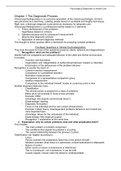Samenvatting
Summary Psychological Assessment with the MMPI-2 / MMPI-2-RF, ISBN: 9780415526333 Psychological Assessment
- Instelling
- Tilburg University (UVT)
This is a full summary of the book, divided per chapter, with notes from the professor
[Meer zien]















